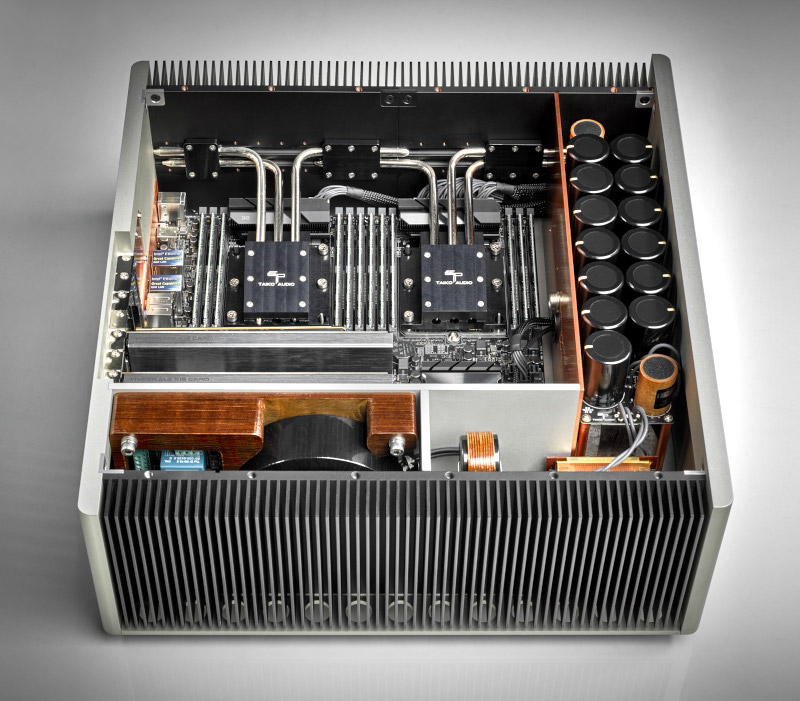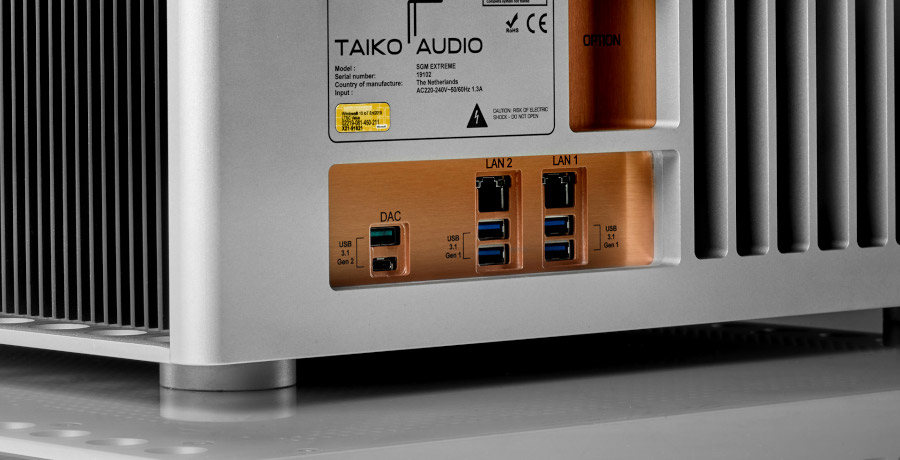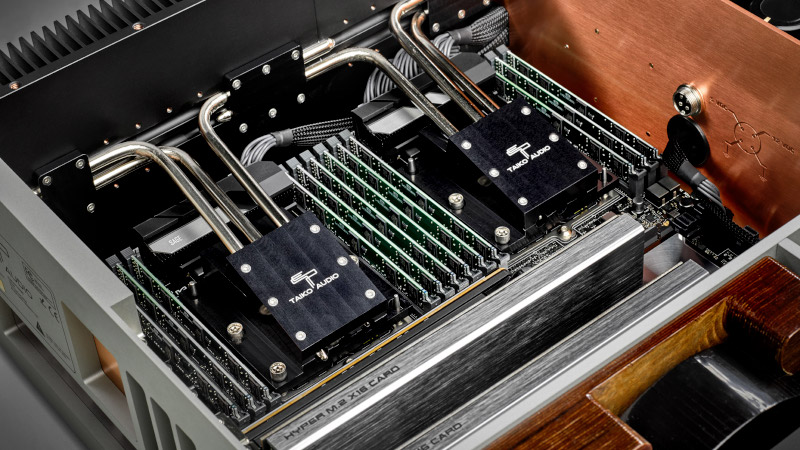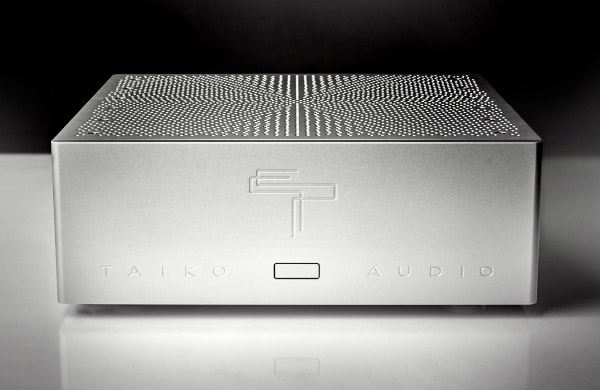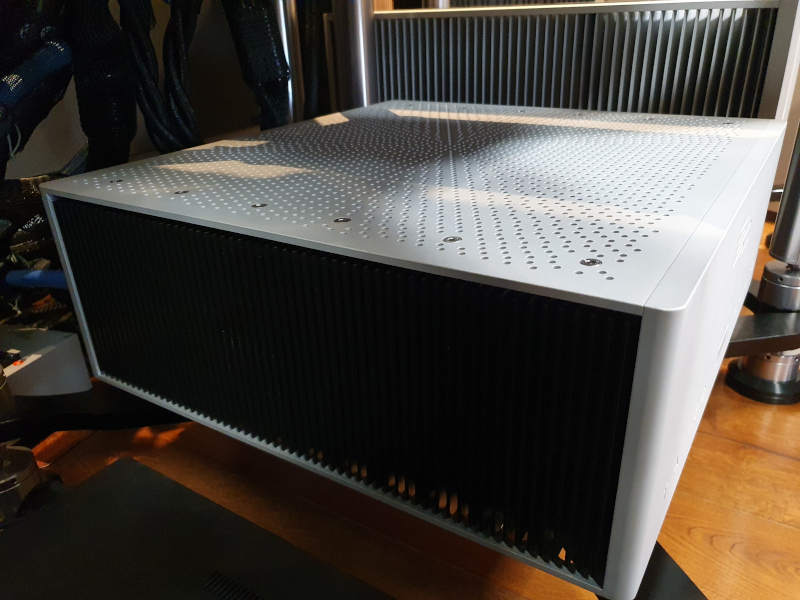TAIKO Extreme
Digital sources
The quality of audio playback needs to be built from the beginning of a playback chain, not from its end. So, as much as loudspeakers are important, it is the room acoustics, the power grid quality, and the source component quality that makes or breaks the result. The Taiko Extreme will not improve your room acoustics, but it represents one of the finest – if not the finest – signal sources available, no matter whether we speak of analogue or digital.
Function and form
The Taiko Extreme server/streamer combines – in essence – an operating system, data processing, and storage capabilities. Not unlike a home computer. In the heart of it, there are two Intel Xeon Scalable 10-core processors, one dedicated for operating system tasks, the other for audio playback tasks. The CPU build a lot of heat, so Taiko had to design internal passive cooling system that is devoid of fans, and therefore the Extreme remains quiet in operation. Apart from the 280GB internal memory that is reserved for the operating system, and 48GB RAM, the music library can be stored on 2TB quad-level cell drives (QLC) that are used instead of usual solid-state drives (SSDs); Taiko Audio explains it as necessary to achieve 4x higher speeds and higher storage capacities at the same time. The storage can be optionally expanded in 2TB increments to maximum of 24TB, that is about 370 thousand songs can be saved in the Taiko, no NAS needed. Although it is possible to use RAID to mirror (back-up) data on disks, Taiko Audio argues that quality suffers and therefore recommends using an external backup drive which can be accessed remotely via the Extreme.
One of the Extreme’s goals is to provide the least possible latency to the signal processing, therefore its operating system (based on Windows 10) has been stripped to the core, and the data output is “bit perfect” without any oversampling or upsampling. The latter is not necessary anyway, for a DAC that connects to the Taiko server may or may not employ further data processing; this way the DAC choice is yours.
The electric part of the Taiko Extreme Server employs low-tolerance parts from Lundahl (transformers), and Mundorf and Duelund (capacitors) in an in-house designed 400W linear power supply. The all aluminum chassis is designed not to emit neither accept EMI/RFI noise. Taiko Audio gives an example of thousands of openings in the heavily perforated lid of the Extreme that should help attenuating emissions by 81dB. Strategic points are braced with copper and resin-impregnated plywood (a ka Panzerholz) to control vibrational behaviour of the unit.
The Extreme server is heavy (45kg) and comes in anodized silver or black. Its front plate is simple and beautifully machined, with only one rectangular button lit by white light. Sides are occupied by heatsinks, the back hosts 5 USB ports, 2 RJ45 ethernet ports in copper, 1 fiber SFP open slot ethernet port, and 1 VGA port. S/PDIF and AES/EBU modules are available optionally.
Should you need a help, Taiko Audio provides an online assistance. They will connect remotely to the unit and set everything for you. I assume Microsoft should take a lesson from them.
Bass management
I skipped the internal storage and used the Taiko Extreme exclusively as a Roon client, that is in its streaming mode. That was not my first-time encounter with the Taiko, but no matter what set-up I listened to it in, it has always been a stellar performer. I went so far that on the opportunity of reviewing YG Acoustics Sonja 2.3i speakers I challenged the Taiko with top league analogue gear, Kuzma Stabi R with DS Audio Grand Master and the corresponding DS phono preamp. It was an eye-opening comparison. No matter how hard the vinyl playback tried and despite its undeniable beauty, the digital stream through the Taiko was better in all objective (and subjective) parameters.
The Taiko builds the sound in an exquisite way. Like a Rock is a song from Dave's True Story album. The song is a cover version of Fever, with different lyrics (provided by Dave Cantor) and different arrangements. Fever was born in 1956, when it was performed by Little Willie John to some limited acclaim. The real history of this rhythm and blues track was written two years later, when it was re-arranged and re-written for Peggy Lee. Since then, it has been re-performed and covered by almost anyone in show business, and there are hundreds of versions of it. Like a Rock is not among the best from artistic perspective, yet it is a well recorded piece that really shone through the Taiko. The Extreme streamer virtually extracted every single bit from the recording, but instead of sending the music into the room through speakers, it let it materialize in space. Often reviewers use phrases like ‘the sound is effortlessly leaving the speakers’ or ‘the sound was inviting’ or ‘the sound was projected forward from the speakers’. None of it applied here. There was a moment when there was utter silence in the room before the play button was pushed, and there was the music. Instantly, everywhere. The double bass, the singer, the snapping fingers, the vibrato of the electric guitar. Everything just materialized in the room, with fantastic presence and aliveness. The level of detail was incredible and the bass solo provided abundance of string resonances, the wood resonances, the fingers on the fretboard, the soft sounds of the player’s shirt, and his mouth inhaling. The dynamic reserve of the Taiko Extreme was enormous, so it was not important how loud I played the track; the sound maintained its ultra-resolving quality, musicality, and aliveness, and was absolutely free of any distortion or smear.
Clarity & delicacy
As you can check in this review’s footer, I used Rockna Wavedream DAC to convert digital to analog. The Wavedream DAC is Rockna’s flagship and I believe it is still one of the finest DACs available. For the Rockna’s own Wavedream NET streamer was in the room too, I wanted to know how the flagship Rockna combo would stack against the Taiko. To be fair, the Wavedream NET costs one third of the Taiko, however the NET should have had a theoretical advantage, for both the Rockna devices were interconnected through the I2S interface and were optimized for each other. The Extreme does not provide the I2S, so I used ‘ordinary’ USB. Other than that, the playback chain was 100% identical for both the digital front-ends.
Going back to Like A Rock, the differences were not subtle. The first and the most obvious is the way the sound arrives at the room. The as-if-from-nowhere materializing effect of the Taiko Extreme was replaced by listening to the system. The music became connected to the loudspeakers again with the Wavedream NET, and although the sound was overall good, it lacked the natural presence quality of the Taiko. After I adjusted to the Rockna’s way of presentation, it became also clear that the Taiko had much better dynamic handling, both on the macro in micro scale. The Wavedream NET was flat-sounding and its dynamic resolution was rougher than the Taiko’s.
Tonal accuracy
Janine Jansen’s take on Antonio Vivaldi’s Four Seasons (Decca, 16bit/44kHz) is a beautiful interpretation with accomplished playing technique. The recording itself is a good one, although perhaps not the audiophile quality. Yet, through the Taiko Extreme, the violin was a real treat, wonderfully dynamic and rich in colours. With my eyes closed, the instrument was in the room and very alive. The Wavedream NET tried hard; the problem was that I could hear that it tried hard. The sound was forced out of the speakers and although there was abundance of detail, the detail was not the result of seeing deeper into the recorded material. The Rockna streamer highlighted the lower treble, so I could hear more noises from the orchestra and seemingly more ambience too, however these were not adding to the enjoyment of the music and were disconnected from the instruments. In the end, the sound as if had to travel through electric mist and the music lost its flow.
I got similar results with the all time classic Money for Nothing (Dire Straits). Towards the end of the „I want my MTV“ intro, and just before the ZZ Top-inspired Knopfler’s Les Paul guitar kicked in, the climaxing intro sound was rendered almost unpleasant through the NET, with too much presence and shrill. The Taiko Extreme’s style of playback crushed the Rockna with ease and made the sound much better organized and free-flowing. Although Taiko Audio recommends totalDAC convertors for the Extreme, you should not get discouraged by this advice. Remember – the Taiko was connected to the Wavedream DAC and the sound was glorious. One of the take-aways, except that the Taiko is a fantastic front-end, is that the Wavedream DAC is a fantastic DAC. It just need a good source and the NET’s capabilities are too limited. True, one also needs to consider the price difference. I would love to compare the Extreme to Pink Faun or Wadax Atlantis streamers, unfortunately such a comparison is quite hard to organize.
Spatial resolution
The soundstaging capabilities of the Taiko Extreme are closely linked to the way the streamer organizes the details and connects them to individual sources (instruments and voices). This helps recreate the performance authenticity. Although there is next to zero natural ambience in Money for Nothing, the Taiko Extreme managed to build a tunnel in time that let me see the electrons flowing from the Knopfler’s guitar amplifier. I also loved the rounded punch of the electric bass (Illsley) and the dynamics of the drum kit (Williams). Until now I would not say that a streamer could have an important influence on bass quality. But listening to Hotel California (Eagles) through the Taiko was an extremely mesmerizing experience, and the bass lines were among the best renditions of this track I have ever heard.
To spent 30 thousand euro on a streamer is a silly proposition. On a pair of loudspeakers, yes. On an amplifier, yes. But on a PC case to play music? Come on! However, after spending several listening sessions with the Taiko Extreme, there are two beasts fighting inside me. The more peaceful one says Be happy that you do not stream music, there is no need for the Taiko. The other entices me Why don’t you stream? Do you see what you’re missing? For this moment, the first one wins. Yet, I have to admit, the Taiko is by far the best source I have ever auditioned.
Recommended resellers
Dreamaudio, Bratislava, +421 907 838 806
Manufacturer's website: http://www.taikoaudio.com
Associated components
- Sources: Rockna Wavedream NET streamer, Rockna Wavedream DAC, Pilium Devine Line DAC Elektra, Ypsilon 1000SE DAC Silver Edition, Paul Pang Quad Switch, QSA Switch, Kuzma Stabi R, 4Point Single tonearm, DS Audio Grand Master cartridge, DS Audio Equalizer
- Amplifiers: Ypsilon PST 100MkII Silver Edition pre, Ypsilon Hyperion monoblocks, Pilium Devine Line Ares pre, Pilium Hercules monoblocks
- Loudspeakers: YG Acoustics Sonja 2.3i, Revival Audio Atalante 5
- Interconnects and speaker cables: Siltech Triple Crown, Vyda Laboratories Orion, Vyda Laboratories Koral, Stage 3 Xphynx, Synergistic Research SRX, Crystal Cable Van Gogh, Rockna I2S
- Power conditioning: Pilium DCF, Torus Power AVR2 16 Elite Series, Stage 3, Siltech Ruby Mountain, DS Audio ION-001
ACCUPHASE DG-58
The Accuphase DG-58 is a 4th generation 'voicing equalizer' of Japanese manufacturer. The device won me over with its impeccable finish, top notch operation and a friendly user interface. It comes in traditional satin gold with high ...
Recommended resellers
Nisel SK, Bratislava, tel. +421 905 203 078
ACCUPHASE DP-720 SACD
Accuphase engineers further expanded on the features that had made their DP-900/DC-900 transport/DAC combo so phenomenal - the result is the one-box DP-720. This player is built with almost fanatical attention to detail. The ...
Recommended resellers
Nisel SK, Bratislava, tel. +421 905 203 078
ACCUPHASE DP-770 SACD
Every new product from this Japanese manufacturer is a small feast, especially if it is a device positioned at the top of the product line. Also, although affordability may be a relative term, spending under 20,000 euro for a digital ...
Recommended resellers
Perfect Sound Group, Praha, tel. +420 722 960 690
Nisel SK, Bratislava, tel. +421 905 203 078
ARIES CERAT Kassandra II Reference DAC
After spending time with the Aries Cerat device I believe I better understand why there is so much enthusiasm about the brand in hifi circles. The Kassandra DAC, if set up properly, provides pure and strong sound that combines ...
Recommended resellers
Mecca Highend s.r.o., Vraclav, +420 732 576 216
AUDIOLAB 8300CD
The 8300CD is a preamplifier, a CD player and a DAC (ESS Sabre), all in one neat package. Audiolab offers 8300MB monoblocks that are half-width of the 8300CD so the two monos and one source component create a compact high end system. ...
Recommended resellers
Horn Distribution, Praha, +420 272 656 485
AUDIOQUEST Dragonfly Red
The original USB DAC of Audioquest happened to be a small revolution back in 2012. Four years later there are already more newborn dragonflies – v1.2, Black and Red. This review is focusing on the latest Red version that has ...
Recommended resellers
AQ s.r.o., Červenka, tel. +420 585 342 232
AYON CD-07s
Smooth liquidity is another typical element of the Ayon sound. The sound is analog-like, viscose, fluid, flowing, smooth. You may as well discard all these adjectives and replace them with the single formulation: the Ayon is a ...
Recommended resellers
Nisel SK, Bratislava, tel. +421 905 203 078
